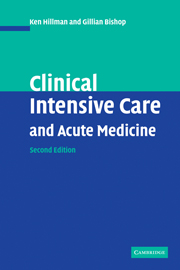Book contents
- Frontmatter
- Contents
- List of troubleshooting tips
- Preface to the first edition
- Preface to the second edition
- Acknowledgements
- 1 A systematic approach to caring for the seriously ill
- 2 Organisation of an intensive care unit
- 3 Routine care of the seriously ill
- 4 Fluid therapy and electrolytes
- 5 Nutrition and metabolism
- 6 Acid–base balance
- 7 Sedation, analgesia and muscle relaxants
- 8 Shock and anaphylaxis
- 9 Multiorgan failure
- 10 Cardiopulmonary resuscitation
- 11 Body temperature disorders
- 12 Transport of the seriously ill
- 13 Infection
- 14 Trauma
- 15 Poisoning
- 16 Acute respiratory failure
- 17 Interpretation of the portable chest film
- 18 Specific respiratory problems
- 19 Ventilatory techniques
- 20 Cardiorespiratory monitoring
- 21 Acute cardiovascular failure
- 22 Specific cardiovascular problems
- 23 Acute intracranial disasters
- 24 Specific intracranial problems
- 25 Critical care neurology
- 26 Acute renal failure
- 27 Critical care gastroenterology
- 28 Critical care haematology
- 29 Critical care endocrinology
- 30 Obstetric emergencies
- 31 Economics, outcome and ethics in intensive care
- Appendices
- Index
- References
2 - Organisation of an intensive care unit
Published online by Cambridge University Press: 07 September 2009
- Frontmatter
- Contents
- List of troubleshooting tips
- Preface to the first edition
- Preface to the second edition
- Acknowledgements
- 1 A systematic approach to caring for the seriously ill
- 2 Organisation of an intensive care unit
- 3 Routine care of the seriously ill
- 4 Fluid therapy and electrolytes
- 5 Nutrition and metabolism
- 6 Acid–base balance
- 7 Sedation, analgesia and muscle relaxants
- 8 Shock and anaphylaxis
- 9 Multiorgan failure
- 10 Cardiopulmonary resuscitation
- 11 Body temperature disorders
- 12 Transport of the seriously ill
- 13 Infection
- 14 Trauma
- 15 Poisoning
- 16 Acute respiratory failure
- 17 Interpretation of the portable chest film
- 18 Specific respiratory problems
- 19 Ventilatory techniques
- 20 Cardiorespiratory monitoring
- 21 Acute cardiovascular failure
- 22 Specific cardiovascular problems
- 23 Acute intracranial disasters
- 24 Specific intracranial problems
- 25 Critical care neurology
- 26 Acute renal failure
- 27 Critical care gastroenterology
- 28 Critical care haematology
- 29 Critical care endocrinology
- 30 Obstetric emergencies
- 31 Economics, outcome and ethics in intensive care
- Appendices
- Index
- References
Summary
The specialty of intensive care medicine
It is generally agreed that the specialty of intensive care medicine began in Copenhagen in the early 1950s. During the poliomyelitis epidemic at that time, patients were treated by tracheostomy and prolonged manual ventilation. As a result of those measures, the mortality rate was reduced from 87% to an impressive 40%.
Although there are now many types of intensive care units (ICUs), such as medical, paediatric, respiratory, surgical, neurosurgical, cardiothoracic surgery and trauma, they all perform the same basic function: caring for the seriously ill. Caring for a group of these patients in a single space makes economic and medical sense. Our expertise in intensive care has increased enormously since the early 1950s and there are now specialised medical and nursing staff devoted solely to intensive care medicine.
Specialists working with the seriously ill may be familiar with complicated technology, physiology and pharmacology, as well as conventional medicine. However, it is even more important to become familiar with the unique requirements of critically ill patients – to develop expertise in their individual patterns of illness. These patients often do not conform to the conventional artificial divisions of medicine: ‘surgical’ patients develop ‘medical’ diseases. ‘Medical’ patients may develop ‘surgical’ diseases. The body may be looked at as a whole rather than as a series of independent organs. This requires that we break away from the tendency toward increasing medical specialisation based on individual organs.
- Type
- Chapter
- Information
- Clinical Intensive Care and Acute Medicine , pp. 7 - 14Publisher: Cambridge University PressPrint publication year: 2004
References
- 1
- Cited by



